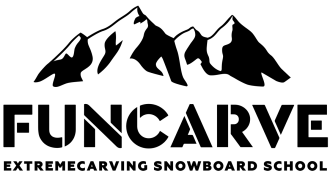Carving technique. High-Speed Freeride
The example of higher mastery of snowboarding is the speed carving on off-piste. By combining secure inclinations and rotation with smooth vertical motion you will get the most exciting emotions from the speed when riding deep snow.
Myths and Reality
- Narrow snowboards for carving sink in the snow;
- Stiff boards of soft geometry ride deep snow poorly because the nose of the board doesn’t bend and doesn’t rise to the surface;
- Big angles of edging of the board lead to the fact that the board cuts the snow by its edge and deepens into the mass of snow.
- It is hard to make long walks in hard boots to reach untouched slopes.
And only a part of these myths is true. Narrow boards really sink in the snow because they don’t have enough width to ensure enough lifting force. That’s why many riders take two boards of different geometry when they make trips to the big mountains. As for stiff boards of soft geometry you will learn to ride them off-piste if you learn how to shift your centre mass along the board depending on the relief. Sure on flat areas such board will sink its nose in the snow but is it really fun to ride such slopes?
Big angles of edging can also become a problem to those riders who cannot control them and they can cause serious falls at high speed. Many riders consider that it is pretty comfortable to walk up the hill in plastic boots and don’t see any problem in it.
Typical snowboarder finishes making their progress in three weeks when they learn to keep their weight on the leading foot and to wag their back foot and they are ready to become a star of regional slopes. However later in big mountains it becomes impossible for them to ride in such style because incorrect weight distribution makes board sink in snow, speed gets lost and a rider hardly has any fun. Besides, active slowdown by kicking out your back foot when you ride off-piste is a very dangerous way of decreasing the speed. Most often in this case the board turns across the direction of movement and freerider catches an edge and makes a dozen of handsprings. It is good that in such situations riders rarely can be seriously injured but the situation is very frightening.
Carving off-piste. How to?
- Powder reducing speed of the board;
- When the nose of the board is loaded with weight it can easily deepen into the snow and the board will quickly lose the speed;
- You can hardly break a carve because your board goes deep into the snow for one third or more;
- The angles of edging become critical already at 40-45°, and your board can go too deep into the snow;
- Falls into the deep snow are not as harmful as those on a groomed slope.
- By taking into consideration these peculiarities and correcting the technique of movements you can get exceptional fun by making carves on snow fields at high speed.
High-speed freeride
First of all you need to understand that the technique where you kick out your back foot will never give you the speed and fun that you would like to achieve. This technique is characterized by constant losing the speed a little and deep snow is slow itself so there is no sense to lose the speed in it. You need to know how to ride on edges at groomed slopes and how to use actively vertical motion and inclinations. Then you will not experience any difficulties when riding off-piste because you will simply adapt your skills to new conditions.
So you need to take into consideration the following:
- You need to feel very well your centre mass in order to shift your weight along the board depending on relief, downgrade and width of the slope. By shifting your weight a little bit more to the nose of the board you will easily ride narrow areas of the slope;
- You need to adjust your bindings for freeride: you should decrease the angle of highback bending, decrease the angles of your stance;
- You should use actively vertical motion however you should pay a lot of attention to the smoothness of your movements when unweighting the board;
- When you weight the board by unbending your knees in the turn you should try to amortize imperfections of the slope;
- Feel free to choose inclinations however control the critical angles of board edging by keeping them up to 40-45° only;
- To decrease the speed you should shift your weight a little to the nose of the board and make the unweighting of the board a little bit faster than in usual turn.



